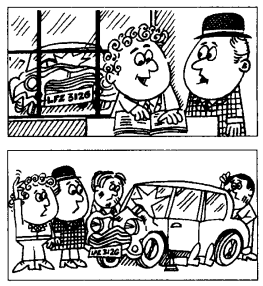one|Lesson 81~80
Lesson 81~82
✨课文

✨单词
have用法③
⚡本课重点
have用法③:have(+a)+名词,作用是将名词「动词化」。其中have作为实义动词使用,可以代替一些常用动词,例如eat、enjoy、drink、take等。这时它就有各种时态上的变化了
- 现在进行时(
be V.ing):I'm having lunch.、She's having a bath. - 一般现在时(
have/has):I have a bath every night.、She has breakfast every morning.- 否定句和疑问句时必须用
do/does:He doesn't have lessons on Friday.、Does he have lessons on Friday?
- 否定句和疑问句时必须用
- 一般过去时(
had):I had a meeting 2 hours ago.、He had a party last night.- 否定句和疑问句时必须用
did:We didn't have lunch.、Did you have lunch?
- 否定句和疑问句时必须用
- 一般将来时(
be going to V.):I'm going to have a bath tonight.
因为到本节课为止只学了这四个时态,所以先只列出这四个时态的用法
Lesson 83~84
✨课文

✨单词
现在完成时
⚡本课重点
现在完成时:动作发生的时间是「过去」,动作的状态是「完成」。核心结构 have/has+V.pp.
此时的have/has在句中的功能类似「主系表结构」中的be动词,用来表示动作发生的时间,而过去分词表示动作的状态。现在完成时不能与表示动作完成的具体时间连用
用法①:「言之过去,意在当下」。大白话讲就是在过去不确定的时间里发生的并与现在有着某种联系的动作,对应中文语境中的 已经...。在之后的89~90课会学习其另一种用法
翻译时需要根据上下文语境和场景,才能知道现在完成时所要表达的真实意思。例如,Do you want to have some food? No, thanks, I have just had some food.,使用现在完成时来回答,字面意思是「我刚才吃过了」,但根据上下文语境,真正想表达的是「我刚才吃过了,肚子很饱,现在吃不下了」
肯定句:
主语+have/has+V.pp.+其他e.g. I've packed my bag.、He has lost his key.
否定句:直接在
have或has的后面加上not即可。主语+have/has+not+V.pp.+其他e.g. I haven't packed my bag.、He hasn't lost his key.
一般疑问句:只需将
have或has提到句首(主语前面)即可。Have/Has+主语+V.pp.+其他e.g. Have you packed your bag?、Has he lost his key?
特殊疑问句:在一般疑问句的句首加上特殊疑问词并去掉答案。
特殊疑问词+have/has+主语+V.pp.+其他e.g. He has lost his key. => Has he lost his key? => What has he lost?
先把陈述句中的
has提到句首得到一般疑问句,再用what对一般疑问句中的答案his key进行提问,并将what提到句首
动词过去分词:过去分词的「规则变化」规律与动词过去式保持一致,在71~72课中已经学习过了。而「不规则变化」只能死记硬背,以后见到一个背一个
's缩写的几种情况
当
's的后面跟着一个名词时,需要结合句子意思进行判断其到底是「is」还是「所有格」e.g. He's a student.、Tony's book is on the desk.
当
's的后面跟着一个V.ing时,表示其为「is」e.g. He's doing his homework.
当
's的后面跟着一个got或动词过去分词时,表示其为have got第三人称或现在完成时第三人称中的「has」e.g. He's got a car.、He's had lunch.
Lesson 85~86
✨课文

✨单词
⚡本课重点
have/has gone:表示「去了」。去了某个地方(可能在路上也可能已经到了),但是没有回来
- e.g. I went to Beijing last week and I am in Beijing now. => I have gone to Beijing.
have/has been:表示「去过」。去了某个地方并且回来了
- e.g. Sally went to Paris last week and she arrived in Beijing yesterday. => She has been to Paris.
ever:常用于否定句、疑问句,以及表示条件的从句
- e.g. Has George ever been to Paris?
never ever:表示「永远」
- e.g. Never ever give up
Lesson 87~88
✨课文

✨单词
动词不定式
⚡本课重点
have用法④:可以和具有动词和名词词性的动词搭配成词组。另外三种用法参考59~60课、61~62课和81~82课
- e.g.
have a look、have a rest、have a crash、have a swin、have a try、have a walk
动词不定式:是一种非谓语动词形式,它没有人称和数的变化,不能在句子中作谓语。其否定形式是在to的前面加not
在英语中,当两个动词紧跟时,它们之间必须加一个不定式符号to。不定式符号后面的动词只能是原形,而不能是过去式或分词形式
当然也是有特例情况的,有些动词是可以在
to的前面加上名词/宾格代词的,即动词+名词/宾格代词+to V.e.g. I want to go school.、Tell him to move it.
| 主动 | 被动 | |
|---|---|---|
| 一般式 | to V. | to be V.pp. |
| 进行式 | to be V.ing | |
| 完成式 | to have V.pp. | to have been V.pp. |
| 完成进行式 | to have been V.ing |
一般式:表示动作通常与谓语动词同时或几乎同时发生,又或是在它之后发生。核心结构为
to V.e.g. He appears to be very happy.、She has decided to sell her car.
进行式:表示正在进行的或与谓语动词同时发生的动作。核心结构为
to be V.inge.g. It happened to be raining when I got there.
完成式:表示动作在谓语动词之前发生。核心结构为
to have V.pp.e.g. I'm sorry to have lost your key.
完成进行式:表示动作在谓语动词之前发生并且一直进行着。核心结构为
to have been V.inge.g. He was said to have been living in London for twenty years.
被动式:当不定式逻辑上的主语是这个不定式表示的动作的承受者时,不定式一般要用被动形式。被动式根据其与谓语动作发生的先后关系,有一般式和完成时两种
被动一般式:
to be V.pp.e.g. These are the books to be given out to the students.
被动完成式:
to have been V.pp.e.g. The novel is said to have been translated into many languages.
修理的四种常见单词的区别
repair:需要有一定的专业技能fix:和repair一样,但更多用在美语环境中mend:一般指修理结构较为简单的东西,不需要特殊的专业技能do up:修理结构更为简单的小东西,例如补衣服,补轮胎
receptionist和attendant:两者都表示「前台服务员」,但在日常生活中,receptionist 的使用频率要比 attendant 高得多
bring:表示「送来、带来、拿来」。在方位上多指朝着说话人而来
yet:表示「直到现在」。用于否定句和疑问句中,通常出现在句尾
- e.g. The train hasn't left yet.、Have you started your new job yet?
try to do sth:尝试做某事
Lesson 89~90
✨课文

✨单词
⚡本课重点
在83~84课中学习了现在完成时的第一种用法,本节课来学习它的第二种用法
现在完成时用法②:一个动作done或者状态been,从过去一直持续或重复到现在的动作或状态。这种用法常常与 for + 时间段(表示持续多长时间)或者 since + 时间点(表示从何时开始)连用。两种用法在结构上是一样的
肯定句:
主语+have/has+V.pp.+其他e.g. I've lived in Beijing since 2008.、He's been working here for 5 years.
否定句:直接在
have或has的后面加上not即可。主语+have/has+not+V.pp.+其他e.g. I haven't lived in Beijing since 2008.、He hasn't been working here for 5 years.
一般疑问句:只需将
have或has提到句首(主语前面)即可。Have/Has+主语+V.pp.+其他e.g. Have you lived in Beijing scine 2008?、Has he worked here for 5 years?
特殊疑问句:在一般疑问句的句首加上
how long,并去掉答案。how long+have/has+主语+V.pp.+其他e.g. I've lived in Beijing since 2008. => Have you lived in Beijing scine 2008? => How long have you lived in Beijing?
先把陈述句中的
have提到句首得到一般疑问句,再用how long对一般疑问句中的答案scine 2008进行提问,并将how long提到句首